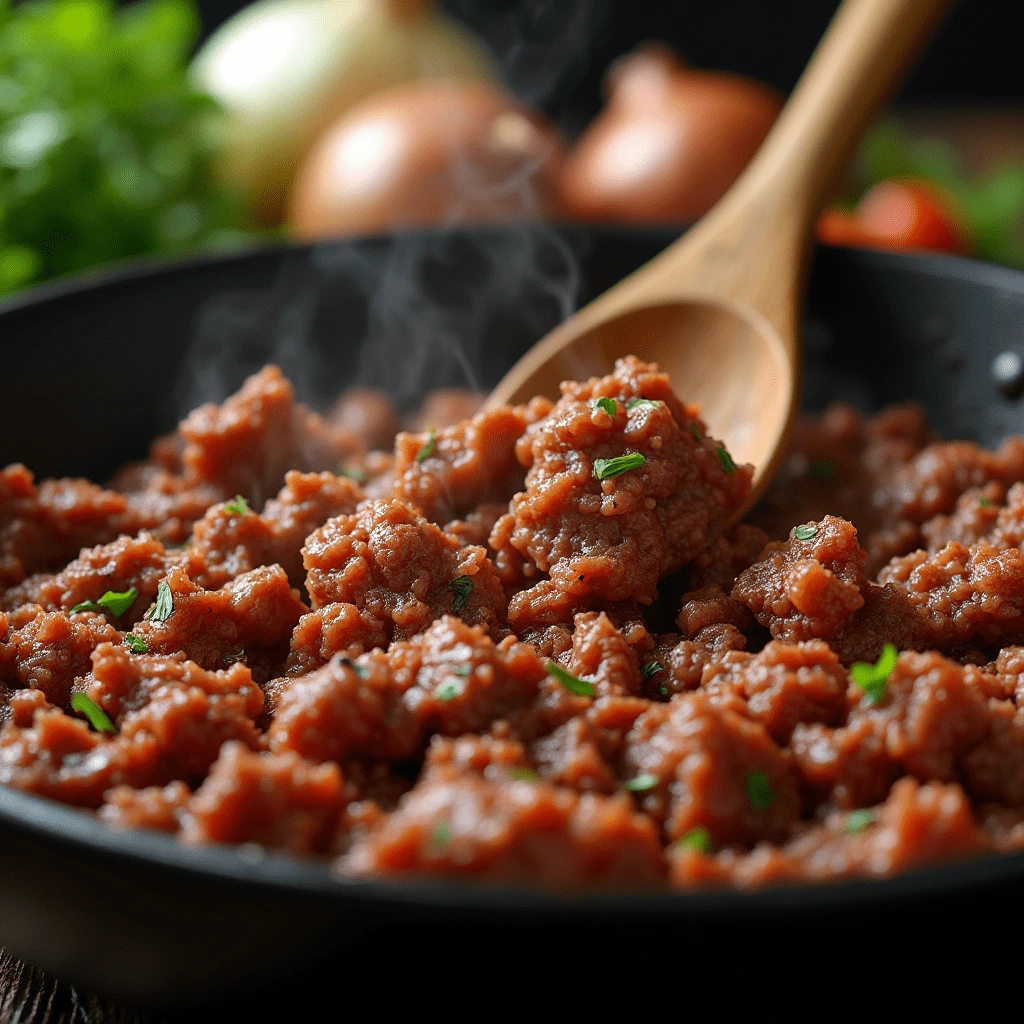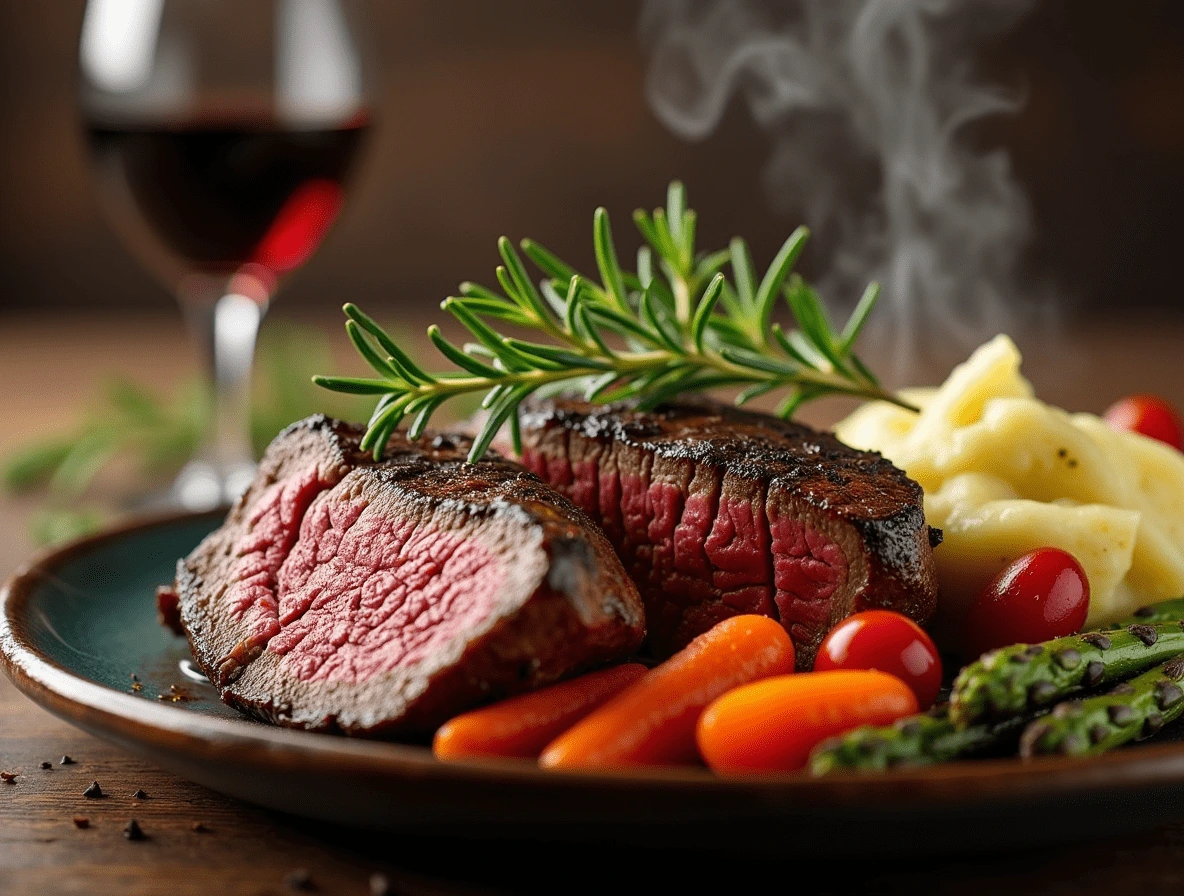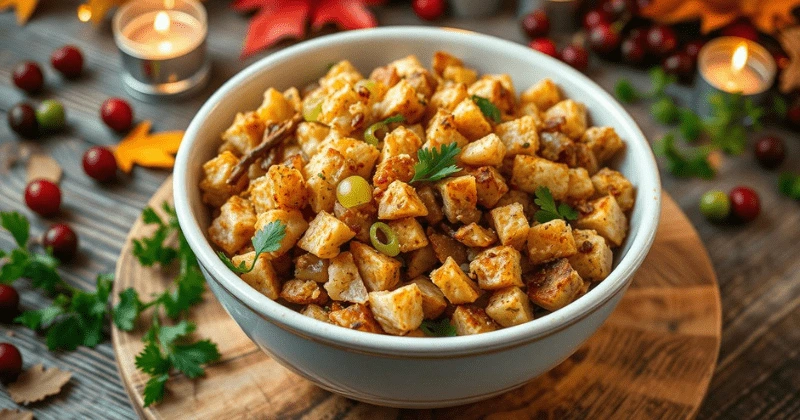The sun shone through the window, filling the air with coffee and sizzling sausage. It was the perfect morning for a homemade breakfast. This sausage and egg casserole with crescent rolls is a comfort food dream. It combines buttery pastry, savory sausage, and fluffy eggs to win your family’s heart.
Table of Contents
Why this casserole is the perfect breakfast dish
This sausage and egg casserole with crescent rolls is a top pick for family breakfasts or brunch. It’s comforting and satisfying, and it’s versatile for holidays or lazy Sundays.
It’s great because you can make it ahead of time. Just assemble it the night before and chill it. This makes mornings stress-free, perfect for busy days or hosting guests.
The combination of savory sausage, fluffy eggs, and a buttery crust is amazing. The sausage and eggs pack protein, making it a nutritious start to your day.
You can customize it easily. Use turkey sausage, Canadian bacon, or plant-based options. Add toppings like roasted red peppers or avocado to make it your own.
In short, this casserole is ideal for any breakfast or brunch. Its convenience, flavors, and flexibility make it a hit with everyone.
Essential ingredients and equipment needed
You’ll need some key ingredients and kitchen tools to make a tasty sausage and egg casserole with crescent rolls. Let’s look at what you’ll need:
Kitchen tools required
- A 9×13-inch baking dish or casserole pan
- A mixing bowl or blender for whisking the egg mixture
- A skillet for cooking the sausage
Key ingredients list
The main ingredients for this breakfast casserole include:
- Crescent rolls: An 8-count package of refrigerated crescent roll dough is recommended for this recipe.
- Breakfast sausage: Your choice of pork, turkey, or chicken sausage will work well.
- Eggs: Approximately 8-10 eggs are needed to create the custard-like filling.
- Cottage cheese adds a creamy texture and extra protein to the casserole.
- Cream cheese: Softened whipped cream cheese helps bind the ingredients together.
- Colby Jack cheese: Shredded cheese is sprinkled throughout the layers for a cheesy flavor.
- Seasonings: Salt, pepper, and your favorite breakfast spices can be used to enhance the taste.
Ingredient substitutions
If you want to try something different, you can use other cheeses like cheddar or mozzarella. You can also swap the pork sausage for turkey or chicken sausage. For a vegetarian option, sautéed vegetables can be used instead of sausage.
Preparing your kitchen for cooking
Mastering the morning baking of a tasty sausage and egg casserole with crescent rolls begins with kitchen prep. Start by heating your oven to a warm 375°F (190°C). Also, grease a 9×13-inch baking dish well to avoid sticking. Then, collect all your easy breakfast recipe ingredients and tools, ensuring the cream cheese is soft.
Having everything ready makes cooking more manageable and the casserole assembly quick and simple.
To ensure a smooth and efficient cooking experience, consider the following preparatory steps:
- Preheat oven to 375°F (190°C)
- Grease a 9×13-inch baking dish with non-stick cooking spray or butter
- Gather all required ingredients, including softened cream cheese
- Assemble all necessary kitchen tools and equipment
- Clear counter space for easy assembly and layering
By carefully preparing your kitchen, you’ll be ready to make a delicious sausage and egg casserole with crescent rolls. It will surely impress your family and guests.
Breakfast crescent rolls: Foundation of the casserole
Flaky, buttery crescent rolls are the heart of this tasty breakfast casserole. Pressing the dough evenly into the baking dish is crucial, as this makes a strong, golden crust for the filling.
Working with Crescent Roll Dough
When working with crescent roll dough, be quick and gentle. This prevents tears and ensures even layers. Roll out one can of flaky pastries and press it into the dish. Then, roll out the top layer’s second can of buttery crescent rolls. Pinch the seams to seal the crust.
Tips for Perfect Layering
- Ensure each crescent roll layer is even for a flaky, golden crust.
- Pre-bake the base layer for 5 minutes to avoid a soggy crust.
- Press the top layer gently to seal gaps and create a smooth surface.
| Preparation Time | 5 minutes |
|---|---|
| Total Time | 25 minutes |
| Baking Time | 14-16 minutes |
| Ingredients | 16 oz crescent rolls, 19.2 oz sausage, 8 oz cream cheese |

“The crescent roll dough is the star of the show, creating a flaky, golden base and top that perfectly complements the savory sausage and creamy egg filling.”
Sausage preparation techniques
Making the perfect sausage casserole begins with the sausage. To get the right texture and taste, follow these steps:
- Begin by browning 1 pound of breakfast sausage in a skillet over medium heat. Use a spatula to break the sausage into crumbles as it cooks.
- After the sausage is cooked, drain off any extra grease. This step keeps your casserole light and balanced.
- For a spicier dish, use spicy breakfast sausage instead of mild. For a leaner option, mix pork, turkey, or chicken sausage.
- Want to add your twist? Mix your favorite sausage casserole seasonings, such as fennel, sage, or thyme, into the ground meat before cooking.
Following these steps will give you a flavorful, seasoned base, which will make your breakfast casserole even better.
“The secret to a great breakfast casserole is in the sausage. Take the time to properly brown and season it for maximum flavor.”
Creating the perfect egg mixture
The perfect egg mixture is crucial for a fluffy, creamy breakfast casserole. Whisk or blend nine large eggs, 1 cup of cottage cheese, and 1/2 cup of whipped cream cheese until smooth. This mix makes it creamy and adds protein for a full feeling.
Mixing Ratios and Seasonings
Seasoning the egg mixture is key. Use seasoned salt, onion powder, garlic powder, paprika, dry mustard, and black pepper. Start with 1/2 teaspoon of each and adjust to taste. These spices add a rich flavor to the sausage and crescent roll base.
Adding Dairy Components
Dairy, such as cottage cheese and whipped cream cheese, makes the casserole creamy and protein-rich. Cottage cheese adds a tang, while whipped cream cheese makes it rich. Together, they make the egg mixture indulgent and satisfying.
For a special touch, add fresh herbs like chives or parsley. Their bright colors and fresh scent add a lovely finish to the egg mixture.

Cheese selection and layering strategy
Choosing the right cheese is key to a tremendous cheesy breakfast casserole. For the best melt and taste, use 2 cups of shredded Colby Jack or cheddar cheese. Place half the cheese on the sausage and egg layer, saving the rest for the top.
This way, you get a perfect cheese pull in every bite, making sure your dish is full of cheesy goodness.
Want to mix things up? Try different cheese combinations in your cheesy breakfast casserole. Mozzarella adds a stretchy texture, while pepper jack adds a spicy kick. Swiss cheese brings a creamy, nutty flavor. The choices are endless when you explore breakfast cheese options to make your dish unique.
| Cheese Type | Flavor Profile | Recommended Use |
|---|---|---|
| Colby Jack | Mild, creamy | Main cheese for casserole |
| Cheddar | Sharp, tangy | Main cheese for casserole |
| Mozzarella | Stretchy, mild | For added texture and melt |
| Pepper Jack | Spicy, flavorful | For a kick of heat |
| Swiss | Nutty, creamy | For a unique flavor profile |
By carefully layering and mixing breakfast cheese options, you’ll make a cheesy breakfast casserole that looks great and tastes fantastic in every bite.
Assembly process and techniques
Making a tasty breakfast casserole with sausage and crescent rolls is about the assembly. Begin by placing crescent roll dough in the baking dish. Spread the browned sausage over the dough evenly. Finally, pour the egg mixture on top, ensuring it’s even.
Building the Layers
To avoid a soggy bottom, par-bake the crescent roll dough for 5 minutes before adding fillings. This step makes the base crisp. After, sprinkle shredded cheddar cheese over the top, covering everything evenly.
| Ingredient | Quantity |
|---|---|
| Ground breakfast sausage | 1 pound |
| Crescent rolls | 2 tubes (8-count each) |
| Large eggs | 6 |
| Sharp cheddar cheese | 2 cups (226 g) |
Preventing Soggy Bottom Crust
Take action early to get a crisp and flaky bottom crust. Partially baking the dough before adding fillings makes a strong base, which prevents the crust from getting soggy.

The secret to a great breakfast casserole assembly is the even distribution of all parts. This ensures that every bite of your layered breakfast dish is full of flavor and texture.
Baking instructions and timing
Timing and instructions matter a lot when baking the perfect breakfast casserole with crescent rolls. Preheat your oven to 375°F (190°C). It usually takes about XX minutes to prepare. This ensures your casserole bakes evenly and the crescent rolls get that golden-brown look.
When your oven is hot, put the uncovered casserole on the middle rack. Bake for 25-30 minutes. Watch it closely, as the top might get too dark. If it does, cover it loosely with foil for 10 minutes to stop it from getting too brown.
The casserole is ready when the crescent rolls are golden, the cheese is melted, and the egg is set. To check if it’s cooked, use a meat thermometer. It should read 165°F (74°C). Let it cool for 5 minutes before slicing and serving.
| Baking Time | Temperature | Cooking Method |
|---|---|---|
| 25-30 minutes | 375°F (190°C) | Bake uncovered, then cover with foil for the last 10 minutes if needed |
Following these baking instructions and timing, your breakfast casserole with crescent rolls will always be perfect. It’s the ideal bake-ahead breakfast choice for your family.
Temperature and doneness indicators
Getting your breakfast casserole just right is key to a great meal. Look for both visual signs and internal temperature to ensure perfection.
Visual Cues for Perfect Cooking
Watch as your casserole bakes. The edges should turn golden, and the center should be firm when gently pressed. This means the eggs have set, and it’s ready to eat.
Also, check for puffed edges and a firm center. If unsure, stick a clean knife or toothpick into the middle. If it comes out clean, your casserole is done.
Using a Meat Thermometer
For extra peace of mind, use a meat thermometer. The center should hit 165°F (74°C). This ensures the eggs and sausage are cooked safely and taste great.
Using visual signs and a thermometer, you’ll know your casserole is perfectly done. It’s ready to delight your family and guests.
Storage and make-ahead options
Preparing an overnight breakfast casserole can save you a lot of effort. It’s perfect for a relaxed weekend brunch or a quick meal prep breakfast idea. This casserole is designed to fit into your busy schedule with easy storage and make-ahead options.
Refrigerating Leftovers
Got leftovers? Store them in an airtight container in the fridge for up to 3 days. It’s a great way to enjoy the casserole again for a quick breakfast later in the week.
Prepare Ahead of Time
- Assemble the entire casserole the night before you plan to bake it.
- Cover the unbaked casserole tightly with plastic wrap and refrigerate overnight.
- In the morning, remove the plastic wrap and bake the casserole as the recipe directs.
Freezing for Later
For more extended storage, freeze the fully baked and cooled casserole. Wrap it tightly in plastic wrap and then in aluminum foil. Freeze for up to 2 months. Thaw it in the fridge overnight before reheating in the oven.
| Storage Method | Shelf Life |
|---|---|
| Refrigerator | Up to 3 days |
| Freezer | Up to 2 months |
These storage and make-ahead options make enjoying this overnight breakfast casserole easy. Prepare it in advance for a hassle-free, delicious breakfast whenever needed.
Reheating methods and best practices
Enjoying the delicious sausage and egg casserole doesn’t have to end after the first serving. With the proper reheating techniques, you can quickly revive leftovers. Whether using the oven or microwave, follow these tips to make your reheating breakfast casserole as good as the first bite.
Oven Reheating Tips
Cover the dish with aluminum foil for the best results and bake at 350°F (175°C) for about 20 minutes. This method keeps the casserole’s texture and prevents the top from drying.
Microwave Instructions
If you’re short on time, the microwave is a quick option for reheating breakfast casserole leftovers. Heat portions on medium power for 1-2 minutes, watching closely to avoid overcooking. For better results, thaw the casserole overnight in the fridge before microwaving.
Following these simple reheating techniques, you can enjoy the breakfast ideas leftovers from your sausage and egg casserole anytime. Every bite will be as flavorful and satisfying as the first.
Flavor variations and customizations
Breakfast casseroles are incredibly versatile. You can change them up to fit your taste and dietary needs. Try out different versions and make your unique breakfast dish.
Swap the sausage for other proteins. Use spicy Italian sausage and mozzarella for an Italian twist. Or, try sautéed veggies like bell peppers and spinach for a veggie option. Add red pepper flakes for a spicy kick.
You can change the cheese to alter the taste. Use goat cheese, feta, or Monterey Jack instead of cheddar. For a richer flavor, add crumbled bacon or diced ham.
Want a healthier option? Add diced tomatoes, mushrooms, or broccoli. There are countless ways to customize your casserole.
Remember, the most important thing is to have fun. Try new combinations and find the perfect mix for your morning.
Serving suggestions and side dishes
Pair the savory sausage and egg casserole with side dishes to make a full breakfast menu. Try a fresh fruit salad, roasted potatoes, or a crisp green salad. These add nutrients and flavors to your meal.
For a fun brunch, offer drinks like freshly squeezed orange juice, coffee, or mimosas. This adds to the festive feel.
Add chopped chives, parsley, or hot sauce to make your casserole look great. Let guests add their own toppings, like salsa, sour cream, or avocado. This way, everyone can make their dish just right.
By mixing the casserole with breakfast casserole sides and a complete breakfast menu, you’ll create a memorable meal. Mixing the main dish and sides will make everyone feel full and ready for the day.
FAQ
How long can you keep sausage casserole?
If kept in an airtight container, a sausage casserole can be safely stored in the refrigerator for 3-4 days. For longer preservation, freezing is an excellent option, allowing it to last up to three months. When reheating dishes like a sausage and egg casserole, ensure they reach an internal temperature of 165°F (74°C) to maintain safety and flavor.
How healthy is sausage and eggs?
Sausage and eggs can be a protein-rich breakfast option, but their health depends on preparation and ingredients. Choosing lean sausage and incorporating vegetables can enhance nutritional value. Eggs provide essential nutrients like choline and vitamin D. In a sausage and egg casserole, balancing portions and using low-fat alternatives helps create a satisfying yet healthier meal choice.
What thickens sausage casserole?
Depending on the desired texture, a sausage casserole can be thickened using flour, cornstarch, or even mashed potatoes. Adding a roux made of butter and flour creates a velvety consistency. In dishes like a sausage and egg casserole, eggs naturally thicken the mixture when baked, ensuring a creamy and satisfying result while maintaining structure and flavor.
How long does sausage egg casserole last in the fridge?
When stored in an airtight container, a sausage and egg casserole can last 3-4 days in the refrigerator. Proper cooling before storage helps maintain its flavor and texture. Reheating to an internal temperature of 165°F (74°C) ensures safety and preserves its deliciousness. For extended storage, freezing is an option, keeping the casserole fresh for up to three months.
Is it safe to reheat sausage casserole?
Reheating a sausage casserole is safe if done correctly. Ensure it reaches an internal temperature of 165°F (74°C) to eliminate potential bacteria. For dishes like a sausage and egg casserole, reheating in the oven or microwave evenly retains texture and flavor. Always store leftovers promptly in the refrigerator to maintain freshness and safety for reheating later.
How long can cooked sausage sit out covered?
Cooked sausage should not be covered for more than 2 hours at room temperature. Bacteria proliferate in the “danger zone” of 40°F to 140°F (4°C to 60°C), making it unsafe to consume after this period. For dishes like a sausage and egg casserole, refrigerate promptly to preserve freshness and ensure food safety for later enjoyment.
Do eggs and sausage have carbs?
Eggs and sausage generally contain minimal carbs. Eggs are naturally carb-free, while sausage may have small amounts depending on added fillers or seasonings. In a sausage and egg casserole, the overall carbohydrate content can increase if ingredients like bread, potatoes, or cream are included. Always check nutritional labels to tailor recipes to dietary preferences or needs.
Are sausages good for you?
Sausages can be a good source of protein and essential nutrients, but their health depends on the type and ingredients. Opt for leaner varieties with fewer additives to reduce fat and sodium intake. Sausages can provide flavor and nourishment while complementing other wholesome ingredients when included in a balanced dish like a sausage and egg casserole. Moderation is key.










